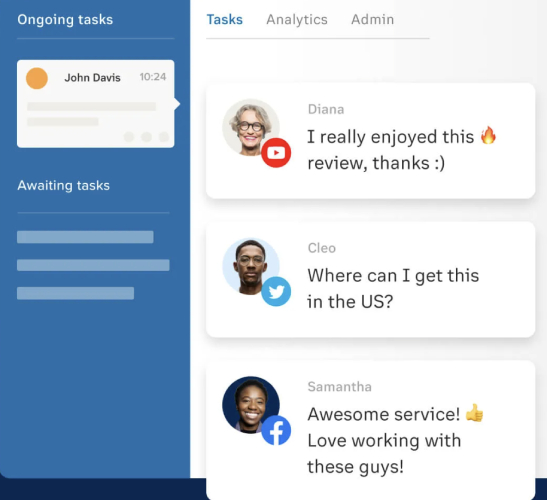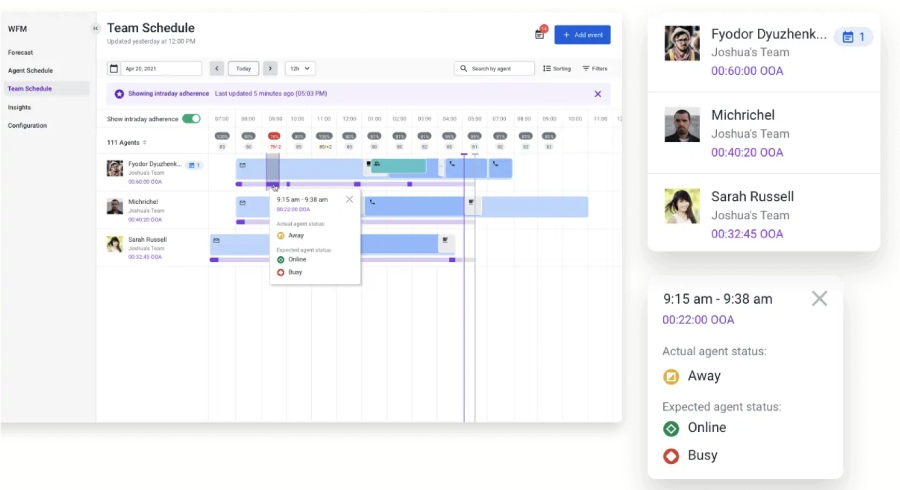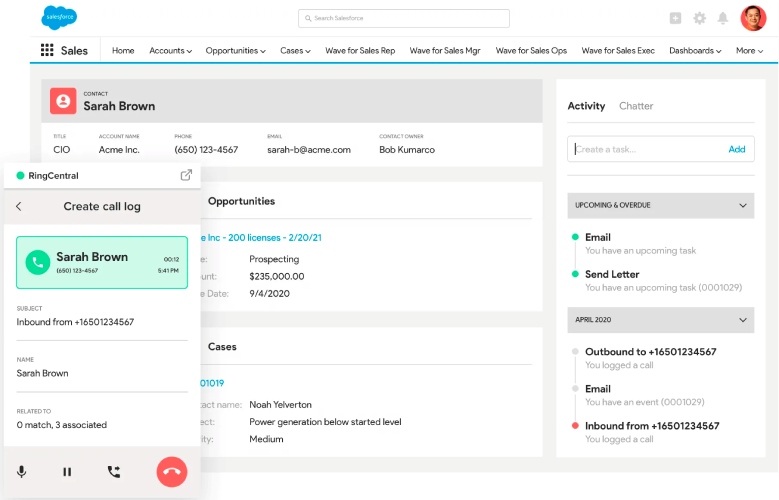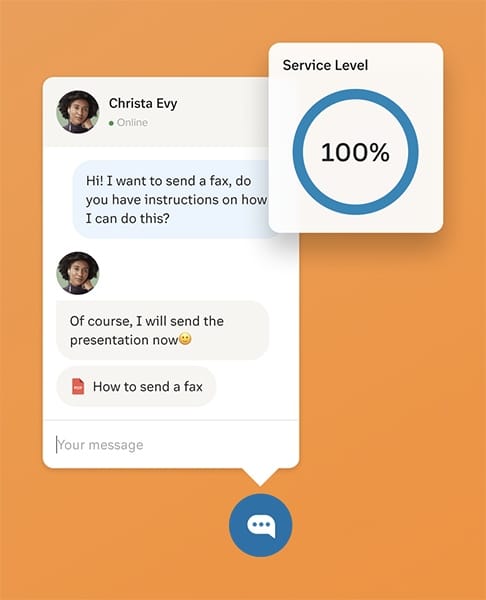An omnichannel contact center provides a unified interface where businesses can manage customer communications across various channels. Supported channels include email, SMS, live chat, and social media, and essential call center features like advanced call routing and workforce management are also available. In this article, we explore what an omnichannel contact center is, its key features, top providers, and benefits.
How Does an Omnichannel Contact Center Work?
Hosted in the cloud, an omnichannel contact center enables automatic syncing of interactions across channels (e.g., email, SMS, live chat, and social media networks) and devices (e.g., desktop and mobile). With this, an agent has a complete historical view of customer activities, letting them deliver excellent service regardless of the stage they come to assist in the customer journey.
Let’s illustrate how an omnichannel platform works for businesses through this step-by-step example:
- A prospective customer uses Facebook to order a product they like.
- A customer service agent sees the inquiry from their dashboard and responds with the delivery schedule.
- The buyer receives a defective product and decides to call the business hotline to return the item.
- Another agent picks up the call and asks the customer to send a picture of the item for verification.
- Without leaving the platform, the agent is also able to access the email sent by the customer and prepare the logistics for the replacement.
- In the same omnichannel contact center, the agent checks the customer’s address from the first delivery, confirms it with the customer, and facilitates the delivery.
With a seamless transaction, including the return and replacement of the item, a business is able to provide excellent customer service, establishing and maintaining customer trust.
Must-have Features for an Omnichannel Experience
The features of the omnichannel contact center spell the difference in how effective the tool will be in your customer service operations. Most of these capabilities are similar to the typical call center platform. If you’re ready to adopt an omnichannel customer service platform, look for these specific tech features:
In a multichannel setup, agents are typically assigned only one communication channel. However, with omnichannel routing, agents are automatically reassigned to another channel with more pending customers. This feature is powered by the artificial intelligence (AI)-enabled automatic call distributor.
RingCentral allows agents to handle large volumes of interactions from different digital channels. (Source: RingCentral)
RingCentral is an omnichannel solution with routing capabilities for digital channels like email, messaging, and social media. This type of platform automatically assigns contacts, taking into account the agent’s skills and workload, the customer’s needs, and the duration of waiting time. This feature reduces average wait times and abandon rates while maximizing agent productivity.
Improving customer service involves enhancing the team’s performance and competence. Most omnichannel call center platforms have workforce management tools for reviewing call transcripts and agents’ daily performance and history.
Talkdesk’s automated scheduling helps you plan accurate agent forecasts using real-time and historical data. (Source: Talkdesk)
Talkdesk is a contact center solution with its very own workforce management software. This provider leverages AI to automate the process of agent staffing, scheduling, and forecasting. It also provides workforce metric visibility, helping you decide what key performance indicators to measure. Whether it’s customer satisfaction score or first call resolution you’re tracking, you can easily monitor them through the transaction logs.
A customer-centric contact center with CRM integrations helps your agents pull up key customer information without switching between different platforms. This allows them to categorize leads, know the caller’s customer profile, and craft the right messages—in just a few clicks.
RingCentral integrates with Salesforce to bring a more collaborative CRM experience. (Source: RingCentral)
RingCentral supports a wide range of CRM apps that let you send and receive calls directly from your CRM platform. This allows the agent to easily retrieve the caller’s account history and customer record once a call comes in. At the very least, your tool must display these important pieces of customer data:
- Demographics: Name, company, contact information
- Interaction and transaction overview: List of conversations across all channels, open and closed tickets, a summary of outcomes
- Customer value insights: Customer satisfaction and customer sentiment (agents must be immediately alerted if they’re catering to a high-value account)
Your omnichannel platform of choice should support popular messaging apps, such as Messenger, WhatsApp, Viber, and WeChat. Customers use these apps when communicating with businesses since they are readily available on smartphones. By having a contact center with messaging app integrations, you easily accommodate this modern consumer behavior.
Integrated messaging apps allow businesses to respond to customer needs more efficiently. (Source: RingCentral)
RingCentral connects with over 200 third-party solutions, including native integrations with chat apps like Messenger. It comes with special functionalities like appointment booking, lead generation, and conversation tracking. With messaging app integrations, you’re able to increase customer engagement—adding a personal touch to your messages and soliciting feedback from customers effectively.
Top Providers of an Omnichannel Contact Center
Now that we have covered the must-have features, it’s time to dive into the specific providers. Not surprisingly, the most popular in the market are the ones that specialize in cloud telephony, including voice-over-internet-protocol (VoIP) phone systems.
Cloud Contact Center Software Providers | Monthly Starting Price (per User) | Key Features | Learn More |
|---|---|---|---|
| |||
 | Custom pricing |
| |
 | $95 |
| No Review Yet |
 |
| No Review Yet | |
 |
| No Review Yet | |
 | $69 |
| |
Benefits of an Omnichannel Contact Center
Now that we’ve covered what an omnichannel contact center is and how it works, it’s time to explore the value it adds to your business. Ultimately, omnichannel services increase customer satisfaction and establish brand credibility. This is because it helps you in these specific areas:
- Improved customer experience: Since an omnichannel service supports multiple channels, you’ll be able to address inquiries on customers’ preferred platforms. The data from interactions is automatically synced in real time, allowing agents to understand the context of an issue and track the entire customer journey.
- Faster resolution times: When you have an omnichannel platform, agents simply look up the customer’s name in the system, and all their interactions with your business will appear. Clients don’t have to keep relaying information, and your team will be able to focus on addressing issues.
- Better remote collaboration: Many omnichannel contact center solutions come with built-in unified communication features to facilitate team collaboration. With this, remote agents can monitor project status, chat with teammates, and share important files. Top call center systems like RingCentral offer a mobile app version, allowing teams to collaborate with ease and access customer data from anywhere.
- Empowered customer service agents: Omnichannel platforms increase agent efficiency by centralizing communication and customer data. This reduces the number of screens needing to be checked, eliminating confusion and information overload. Plus, built-in features like call routing maximize agent skills by directing customers to the right agent who can handle a specific concern.
Omnichannel Contact Center Best Practices
Other than considering the features of an integrated contact center, the way to get the most out of this tool is to follow best practices. The overarching principle in these strategies is anticipating the needs of customers and providing accurate and timely assistance. Here are the best practices for adopting omnichannel contact center software in your operations:
- Include self-service options: Consider incorporating self-service options in your customer service by taking advantage of the interactive voice response (IVR) feature. This allows callers to get the information they need through prerecorded messages without help from live agents. They simply have to select a number on their keypad to choose a menu option.
- Simplify contacting a live agent: To further improve live support and provide the best service to specific customer concerns, use the intelligent routing feature. Set routing rules based on agent skills, taking into account their product knowledge, language proficiency, and certifications. With this, an AI-powered contact center is able to match incoming tasks to the most qualified agents, thereby improving customer service overall.
- Take actions based on the buyer’s journey: As you look at customer data and map out the buyer’s journey, look for patterns in the communication channels customers use for specific concerns. From there, you may be able to draw automated solutions for such scenarios. For example, if customers often engage through social media, use it as an opportunity to automate social media posting on days they are more likely to see your post.
- Be consistent in your customer service across channels: Ideally, consistency should be reflected in different aspects of customer service, including response time and communication style. For example, if a customer initiates an email then later follows up via live chat, agents should ensure that the response and information provided are consistent on both platforms.
- Integrate tools and communications: An omnichannel approach is made possible through app integrations that make all historical data visible to agents in every customer touchpoint. Utilize this capability by adding all the relevant channels to your platform, including customer relationship management (CRM) solutions. Note that the integration should happen the same time you launch a channel, not after, to make sure you capture all customer communications.
Frequently Asked Questions (FAQs)
The main difference lies in data integration. With omnichannel customer service, all customer interactions across different channels are visible on one platform. A multichannel solution allows businesses to provide customer service in several channels. Agents assigned for each channel operate in isolation.
The most popular trends in omnichannel customer service are automation and the use of AI in self-service options. These trends facilitate the growing demand for fast resolution of customer concerns. The tools equally benefit businesses, as they streamline work processes and allow teams to focus on more complex tasks.
The key challenge in an omnichannel solution is point-to-point integration. The practice of connecting each app or chatbot to the contact center is difficult to scale up and not flexible in terms of adapting to new technologies and processes. It’s time-consuming as you need to keep integrating each time a new channel is added. To address this, look for service providers with application programming interfaces (APIs).
Bottom Line
Investing in the best omnichannel contact center software for your company elevates your customer service by putting all customer communications on one platform. Even in the abundance of queries and communication channels, you’re able to stay on top of your business and keep your eyes fixed on the goal—creating a smooth, hassle-free customer experience.



